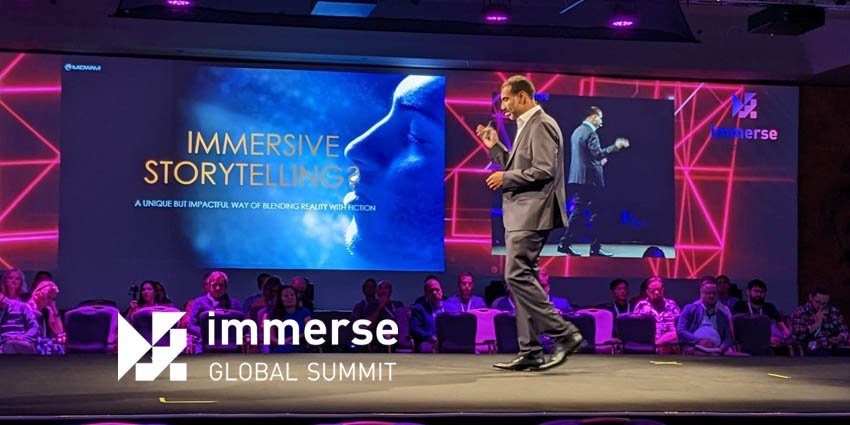Post originally appearing in xrtoday.com by Demond Cureton.
AR tech firm Magic Leap is set to launch in 19 countries across the world, Lisa Watts, Vice President of Product Marketing and Developer Programs for Magic Leap announced at the Immerse Global Summit (IGS) 2022 Europe on Madeira Island, Portugal.
The high-level exec made the comments amid a major discussion panel with some of the world’s largest tech giants.
Watts was joined by Pearly Chen, Vice-President of HTC VIVE, Brian Vogelsang, Senior Director of Product Management for Qualcomm Technologies, and Maria Pace, Head of XR Hardware, Global Partnerships and Strategies for Google.
Kris Kolo, Global Executive Director of the Virtual and Augmented Reality Association (VRARA) moderated the panel.
Announcing the news, she said,
“It’s been a journey to get here. Magic Leap 2 stands on the shoulders of giants and the force of the entire industry”
She mentioned Magic Leap manufactures in Florida, United States, and that the industry realised the difficulty and complexity of producing such devices.
Watts broke the news amid a major discussion on extended hardware (XR) hardware and the key components of creating a stellar immersive device for enterprises and consumers.
Speaking to Kolo about how major tech firms could push immersive technologies for mass adoption, the four representatives responded with expertise from their respective industries.
Smaller, Lighter, Comfortable, Compelling
According to Chen, VR devices were getting “smaller, lighter, more compact, more comfortable, and more compelling” due to advancements in hardware development.
Headsets had shifted from focusing on outside-in and laser position tracking to “more inside-out, where you can be much more portable,” namely with all-in-one computing platforms.
Rapidly developing ecosystems were “fastly evolving and thriving,” Chen said, adding,
“Consumers are finding more reasons to engage with VR first, usually as entertainment to get in the door. But then, of course, we hear all great advocates for VR and immersive applications in enterprise training in productivity learning spaces, where people will start to have much more touch points with this amazing, life-changing technology”
From AR Games to Remote Guidance
Starting with mobile phones, AR technologies had gradually transitioned to head-worn devices, Watts explained while speaking to the panel on enterprise and consumer adoption of AR.
Explaining further, she said,
“I think that is something that is on everyone’s minds [is that] focusing on the enterprise is great for all of us, because we learned so much in high-intense environments that have a lot of demands. So those sorts of things are going to only help the consumer market at the end of the day, but you know what, we’re all forever grateful [for] Pokemon Go because that was really the breakthrough moment where we were like, ‘Oh, I can really see digital content in my real world space,'”
She added that work from companies such as Google, who worked with Qualcomm’s Snapdragon Spaces, would become “critical for us to be able to have a spectrum of experiences.”
Comfort is Key
Regarding the VR and AR side of the industry, Google’s Pace said that her company had “seen the areas of defence going back decades ago,” as it was a first adopter.
The COVID-19 pandemic also fuelled a surge in its adoption for enterprise use cases, which showcased its “productivity, efficiency, [and] even safety as well.”
Form factors were becoming thinner and would continue to do so going forward leading to greater levels of vision, vestibular, and social comfort, Pace explained. She added immersion rates would require “realistic experiences” to boost presence, namely amid the pandemic.
Hardware required comfortable wearables that improved weight, size, thermals, and other components. Visual comfort involved “reducing a lot of the parasitic [related to] ghosting or even light leakage.”
Components of Great XR Devices
The Santa Clara, California-based firm had a unique position many tech companies depended on its components “multiple years before the devices reach the market,” requiring it to plan two to three years in advance, Vogelsang noted.
Trends in XR noted by the tech giant included smaller VR headsets using new optics systems such as pancake optics, he explained.
Blueprint sensors used to track lips and eyes, as well as smaller form factor controllers from firms such as Magic Leap also incorporated small cameras for hand tracking, boosting the device’s six degrees of freedom (6DoF) capabilities.
New MR technologies included red, green, and blue (RGB) cameras for enabling passthrough on headsets with forward-facing cameras, allowing AR overlays on real-world visuals.
Continuing, the executive told the audience,
“I think that’s where we’ll see lots more experimentation. Some of the challenges that we have in the augmented world, like a reduced field of view, can be resolved with that, but it also introduces new latencies because now you’re viewing the real world through a display, similar to your smartphone’s AR, but it’s on your head”
He concluded that Magic Leap’s Puck module was trending, which the devicemaker tethered to headsets to significantly offload processing, but also smartphones were playing an increasing role in tethered interactions with headset devices to reduce form factors similarly.
He said,
“If you look at the Lenovo A3, then there’s a trend to obviously get these [devices] smaller and lighter weight.”
The IGS 2022 Europe concluded on Friday with a massive lineup of conversations, panel talks, keynote speeches, and product demonstrations at the Savoy Theatre, where the global tech community rallied to highlight the top trends taking shape across the sector.
A future IGS 2022 event is set to take place in Miami from 5 to 7 December, leading to one of the world’s largest platforms for immersive technologies to gather and network for the future of the Metaverse.


